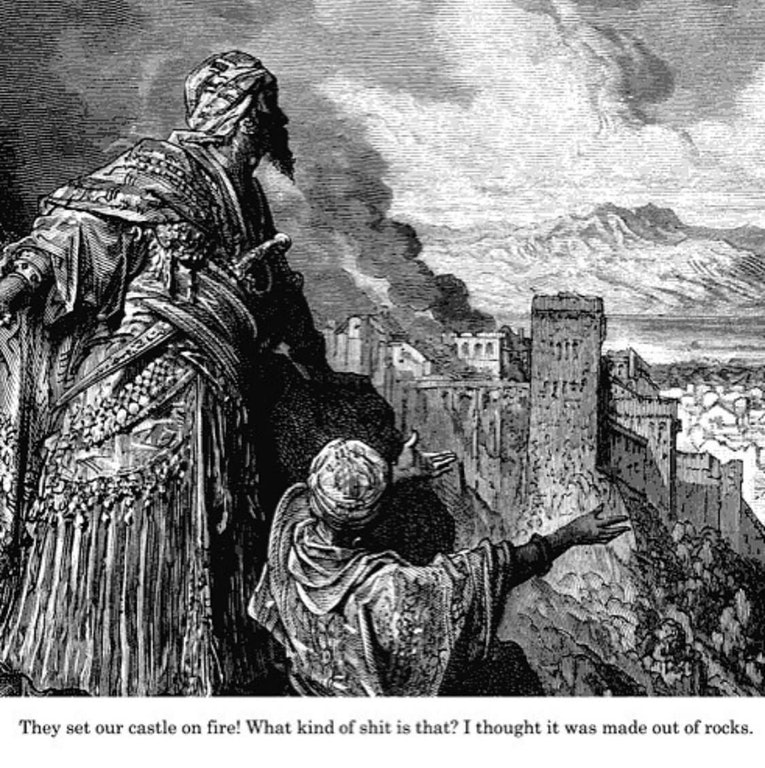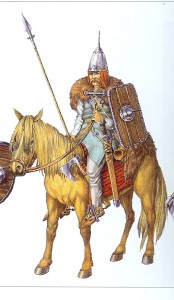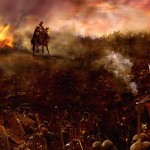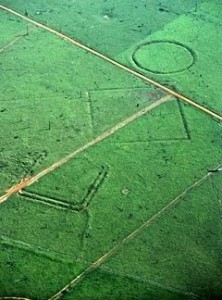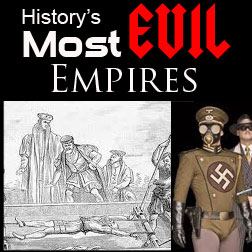Ancient Military History
Ancient Military History Humor
Posted in Ancient Military Humor, Uncategorized
Tagged ancient, ancient warriors, castle on fire, history, humor, military, military humor
Leave a comment
Aztec Weapons
Ancient Aztec Weapons
Every ancient Aztec weapon had a unique and specific use, with Aztec warriors designated to specialize in them. Aztec warfare was very organized, complex and full of ritual and tradition. We know a significant amount about some of the weapons that the Aztecs used, though much of the history has been lost. Manuel Aguilar-Moreno explains:
One finds a repetition of the most important weapons in historical sources, while other weapons receive minimal mention in only a few scattered documents. This suggests that other, less commonly known arms may be forgotten.
Below is information that we have on various Aztec weapons.
The Maquahuitl
The best-known ancient Aztec weapon is the maquahuitl (macahuitl). The maquahuitl is sometimes compared to a sword; it was a powerful, in your face mellee weapon. Like the European sword, they came both one-handed and two-handed. They were about 3-4″ wide and 3-4′ long and made mostly of oak wood. The two handed versions might be slightly wider and could be as tall as a person. In the edges of the wood was lined with obsidian (volcanic stone) or flint. These sharp stones are still used today in the medical field for scalpels and can hold a Maquahuitls were incredibly deadly weapons. The Spanish would say they could chop the head off a horse with one swing. In an account by Bernal Díaz del Castillo, one of Hernán Cortés’s conquistadors, this is recorded.
“Pedro de Morón was a very good horseman, and as he charged with three other horsemen into the ranks of the enemy the Indians seized hold of his lance and he was not able to drag it away, and others gave him cuts with their broadswords, and wounded him badly, and then they slashed at the mare, and cut her head off at the neck so that it hung by the skin, and she fell dead.”
Modern recreations haven’t been able to accomplish this, however, they have been able to cut about ¾ through a pig carcass and most likely are unable to construct the weapons to the high standards of the Aztecs. Unfortunately for the Aztecs the weapons blade wasn’t able to withstand strikes against solid objects, the obsidian blades would shatter or become dislodged.
These weapons were very sharp and the best trained of the Aztec warriors employed them to great effect. The maquhuitl was used in a slashing manner, as it did not have a point for thrusting like a sword.
Clubs
The maquahuitl could be used as a club, but other types of clubs were used as well. One of which was the cuauhololli, which was a mace made of wood with a ball at the end. It was used to smash and crush. Various other types of clubs were also used, sometimes just made of wood and other times with embedded stone like the maquahuitl.
Aztec Spears
Another common ancient Aztec weapon was the spear, called a tepoztopilli. They were extremely sharp and could be over 7 feet long. They didn’t have a small point as many spears do, but instead a blade of up to a foot wide made of smaller stone blades. Theses spears were known to pierce the Spanish armor, and they were sharp enough that the warriors could use them to shave.
The Atlatl
The atlatl was a spear throwing device, for long distance combat.
An atlatl is a wooden rod with a handle on one end and a hook that engages a light spear or “dart” on the other. The flipping motion of the atlatl throws a light spear much faster and farther than it could be thrown by hand.
The atlatl was used in other parts of the world and is still used today. Aztec artists often drew the gods with atlatls. The “darts” were made of oak, single pointed with obsidian, flint, or even copper or bone. The thrown darts tended to be more powerful than arrows.
Atlatls often had a symbolic significance, and some were made very artistically. Hernan Cortes received an atlatl from Motecuhzoma II.
Bows and Arrows
Bows, known as tlahuitolli, were common among the Aztecs as well. The bows were 5 feet long and the arrows (yaomime) were pointed with flint, bone or obsidian, and kept in a quiver (mixiquipilli). As with all their weapons, the Aztecs were very skilled with the bow and arrow. It is believed that their arrows could fly 450 feet or more.
Slings
Another devastating ancient Aztec weapon, the sling, was made with fibers from the maguey plant (agave americana). The slings (tematlatl) were used to throw stones at the enemy. They were thrown so powerfully and accurately, that they could do significant damage to a soldier in full metal armor.
The Aztec warrior didn’t use just any stones, they prepared the stones ahead of time and carefully shaped them. It is believed that the stones could be thrown farther than the arrows could be shot.
Cavalry Comapared to Tank Warfare
A connection between the tactics used in ancient cavalry and modern tank warfare is apparent. Massing cavalry units to break through enemy lines has been a successful tactic since the beginnings of cavalry forces. OK, maybe not the beginning, but over the past 2000 years.
Chariot warfare started thousands of years before cavalry, around 3500 BC. A lot of people
compare the roll of ancient chariots to tanks. (Who? a wiki site would ask, lets just say I’ve run into them.) The problem with this is that at the peek of effectiveness, and they were effective, they were used more as mobile missile platforms. The Egyptians reached the height of their power with swift chariots that quickly moved archers into position to rain pharoahic doom down upon their enemies. These chariots were made to be light and only had an archer and driver. Their greatest rival, the Hittites, liked to make a tougher chariot and supply it with a spear man to boot. However they may not have always avoid smashing into enemy infantry formations.
Later users of chariots did actually use them as a blunt object to try to break up infantry formations, however this is much later after chariots had went from the lords of the battle field to some sort of trick up your sleeve. Famously the Persians tried to send scythed chariots into Alexander the Greats massive wall of men wielding spikes. The story is that they simply cleared a path for the onrushing chariots and picked them off with javelins or their long spears. However, undoubtedly, some of them did die and it was annoying to those in charge of keeping formations. There are a few engagements were this did work, but in general their performance was lac luster and didn’t compensate for the high costs of chariots. The reason for this dip in combat effectiveness was due to the rise of the mounted cavalry. Comparatively, they were coming up short and ending up a novelty.
When you throw in some examples of ancient chariot warfare in India and China, you can draw more conclusions of chariots being used in the same manner as modern tanks would be deployed. However, I would argue that at this point they lacked the effectiveness to be compared to modern tanks as a decisive tactic. This all changed with cavalry.
Alexander used his heavy cavalry to smash through Persian lines in much the same way the Germans did in World War II did through the Allied lines, be that on a much grander scale. However, tactically it was the same thing. Basically, while the infantry closed ranks with the enemy, a mobile spear head would thrust through the enemy and wheel around against the opposing line. There are thousands of examples in military history of both armored divisions and cavalry executing these same maneuvers. More obvious comparisons can be drawn when comparing the encirclement of the Germans forces at Kursk with tanks to the surrounding of the Romans at Cannae by Hannibal.
One key difference, and as military history has progressed since World War II is that air power has become dominant. Much like the chariot had its day, modern tanks too have lost their position as masters of the battle field. As military history moves forward, undoubtedly, another variation of the armored assault will develop. I’m sure their designers will have both blitzkrieg and cavalry in mind.
Posted in Ancient Military, Ancient Weapons, Uncategorized
Tagged ancient, ancient cavalry, cavalry, compare, military, tank, warfare
Leave a comment
The Greatest Ancient Generals
This is a tough question, due largely to the different armies and definitions of what makes a
- The 10 Greatest Ancient Generals
great general. So, I’m just going to skip the explanations since it’s a personal judgment thing anyhow. Now, without any further blathering, here is the official list of the greatest ancient generals from Ancient Military History!
1) Scipio Africanus
He was undefeated, succeeded where others failed given the same armies and he defeated Hannibal. Good job Scipio!
2) Alexander the Great
He was undefeated, but lets face it, his dad gave him that awesome army and even the plan to attack Persia. However, that being said, he did conquer a huge empire and a big chunk of the “known world”.
3) Julius Caesar
He was a good general with a great army. He bested both Roman and Celtic armies, but he’s a little lower on this list than might be expected. The reason is that despite his shameless self-promotion he did end up getting himself into a lot of bad situations. He got out of said situations, but why was he there in the first place? Caesar is definitely the luckiest general on this list though.
4) Hannibal
This guy was a genius at strategy in his prime, he taught the Romans a few bloody lessons. He defeated larger armies than his with better tactics. Basically he got the Romans to fight him where he wanted then surrounded them. Unfortunately, Scipio beat him at the battle of Zama, ending his chances to be higher on this list.
5) Cyrus the Great
He founded the Persian Empire and was a bad ass. He also came up with the trick of using camels to freak out the enemies cavalry. To bad a battle with the Scythians cost him his life though, and worse, it kept him from getting higher on this list!
6) Epaminondas
This Theban general and statesmen lived from 418 BC – 362 BC. He broke the military dominance of the Spartans over the other Greek cities and came up with many innovative tactics. At the battle of Leuctra this generals better tactics led his outnumbered Greek warriors to defeat the superior Spartan hoplites. His innovation consisted of making a mass of his best troops on one side of his line and angling his weaker forces away on the other. His calculations where dead on, unfortunately, despite his victories he didn’t survive the war. Even more unfortunately the Thebans didn’t last long on the top of the Greek food chain since the Macedonians came down and took over just 27 years after his death.
7) Sulla
He was the first Roman General to basically take over the empire at sword point. He didn’t lose a battle and basically kicked everyone’s buts that he met. This guy was awesome, Sulla was a highly original, gifted and skilful general, never losing a battle. He remains the only man in history to have attacked and occupied both Athens and Rome.
8) Sargon the Great
Now, I’m not really sure if he was a great general or just a great political strategist with a kickass army but this guy built what is often cited as the first empire. He went around ancient Summer and kicked but until his reign was cut short by a plane crash. Maybe that was Buddy Holly though?
9) Attila the Hun
Well, this guy may or may not have been the greatest general but he certainly caused a lot of destruction and had huge cajones. They didn’t call him the “Scourge of God” for nothing, he did however lose the Battle of Châlons and he was leading the greatest military force in the western world so he is deservingly low on the list. I mean come on, those Huns were crazy accurate archers and born in the saddle, they should have taken Rome.
10) Marius
Credited with forming the Roman Military into what we think of today, Marius was a soldiers general. He definitely increased the size of the legions, and bettered there training. On the battlefield he defeated two massive hordes of German invaders that had previously wiped out two entire Roman armies.
Civilization in the Ancient Amazon
When most people, including myself until recently, think about the tribes of the Amazon basin they think of small bands of semi-nomadic hunter gatherers who live in small villages. People assume, as did most scientists throughout the first half of the 20th century that this is how life has always been for the tribes of the Amazon. Why would civilization of the Ancient Amazon be any different? However, the conquistadors who first explored the area and reported it to the outside world told a very different story. They spoke of large, well organized cities with white buildings, canal systems and road networks. They reported dense populations spanning for miles along the many rivers, vast kingdoms ruling over thousands of square miles and complex societies that rival that of the Incas and Aztecs. Some tribes were peaceful, while others were as hostile and fearsome as Aztec warriors. These reports were long considered to be exaggerations, fables passed on by the Amazonian Indians like the golden city of El Dorado, but over the last forty years science has unearthed evidence that indicates these reports may have been much more factual than previously thought. It now seems that the pre-Columbian societies of the ancient Amazon were more a kin to known preliterate nations than to their ancestor’s tribes found in the region today.
In 1541 Spanish conquistador Francisco de Orellana inadvertently descended and explored the course of the Amazon. He described many rich, populace and advanced tribes that lived along the Amazon and had roads leading into the interior. Some tribes were savage attacking with their ancient weapons from canoes and opposing any landing the Spaniards attempted, others were advanced but warlike. The most deadly employed poison tipped arrows that killed men simply by grazing them. He also reported advanced, peaceful tribes that assisted him on his journey of thousands of miles down the great river system. However, over the next couple of hundred years these civilizations disappeared, seemingly without a trace. Yet, besides the earliest of reports some interesting facts remained. Amazonian tribes from diverse regions, cultures and language groups consistently told the same stories. Another clue is that some semi-nomadic tribes now found in the Amazon have the odd distinction among tribal indigenous societies of having a hereditary, yet landless, aristocracy. The Amazon is the only place in the world where an aristocratic class can be, or has been, found without a sedentary, agrarian culture.
The tribes of the ancient Amazon left no lasting monuments. However, lacking stone they used wood for their construction, a material which doesn’t last long in the humid climate of the Amazon rain forests. Another thing that has long been pointed out is that the soil is far too infertile to support agriculture, and therefore any large population centers. However, it is now apparent that the pre-Columbian tribes of the Amazon had a way around this problem as well, terra preta.
Terra preta, “black earth” in Portuguese, is a man made soil found throughout the Amazon. It is made by adding charcoal, bone, and manure to the otherwise infertile soil. Terra preta lasts for thousands of years and even has the ability to renew itself. Apparently, micro-organisms and fungi live and die in this porous soil, thus regenerating and even increasing its carbon content. Currently there is a hot debate in the scientific community about this soil and its implications that is tied to Amazonian conservation, land use and agriculture, but it does indicate that the Amazon tribes were able to farm vast swatches of the Amazon basin. Terra preta covers at least 0.1 to 0.3%, (6,300 to 18,900 square kilometres or 2,400 to 7,300 sq mi) of the low forests of the Amazon basin. Higher estimates calculate that tera preta covers 10% of the Amazon, over twice the size of Great Britain.
Over the past twenty years two sites have been uncovered that have sent shock waves through the scientific communities. First the culture of Marajo was discovered on a large island in the Amazons delta. The Marajo culture may have supported 100,000 people and created amazing advanced pottery. Archeologists have unearthed painted ceramics, some larger then a person, beautifully detailed with figures and well thought-out designs. Apparently Orellana wasn’t exaggerating when he said the artists of Marajo could rival any in Europe at the time.
Then in 1999 another great ancient Amazonian Indian society was discovered. The discovery was declared by the media to be the Lost City of Z or El Dorado, and it certainly has the grandeur of the legends if not the gold. Spread out over 7,700 square miles and supporting a population of around 50,000 people and including a network of over twenty towns, Kuhikugu, was built on a scale rivaling that of the ancient Egyptians. A vast network of roads and canals connected the cities, some of which were protected by palisades and moats, while the center of some of the cities featured large plazas over 500 feet long. They also constructed dams and ponds for fish farming and raising turtles. Kuhikugu thrived from around 500 AD until the arrival of the Europeans in the new world.
The conquistadors who reported these advanced Amazonian civilizations also sowed the seeds of their destruction. European diseases killed up to 90% of the Amazon’s Indians and the survivors fled into the jungle to avoid servitude to the foreigners. The jungle quickly reclaimed the fields and towns, leaving only a few clues of the once thriving Amazonian civilizations. These clues have only recently come into light, obliterating the long held perception that the Amazon was to harsh to support anything but small nomadic tribes.
An estimated 500 tribes currently reside in the Amazon, each with its own language, customs and territory. While all European languages stem from one language family, Indo-European, the Amazonian tribal languages stem from 42 families. Some groups remain “uncontacted” to this day.
Tribal life styles and uncontacted peoples can be defended through groups like survival international.
Ancient Roman Weapons

Roman Weapons at Work
Roman soldiers are associated with some of the most iconic weapons of ancient history. The gladius (their sword) and the pilum (their heavy javelin) clearly identify the Roman soldiers to anyone at all familiar with ancient military history. In this article I just want to talk about those extraordinary, less known but no less awesome weapons of the Roman arsenal. For anyone looking for detailed information about the more mainstay Roman Weapons this link is a great resource. For those that want to know about the more unique and interesting ancient Roman weapons please read on!
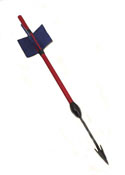
The Roman Plumbata
The Plumbata (The Little Barbs of the War God)
Now in the world of the ancient Romans they considered the Goths to be the trail park trash of the ancient Mediterranean neighborhood. What does trailer park trash fear most? If you guessed a barrage of lawn darts you are correct!
The Plumbata is an awesome ancient weapon that may have been a game changer had it just been introduced a little earlier. Sadly they weren’t introduced until around the late 4th century, but even then two legions armed with them became the top legions of the military. Plumbata essentially provided Roman legionnaires with the ability to fire five salvos of missiles. These lead weighted lawn darts had the velocity to punch through armor and laid wasted to any horse or man unlucky enough to venture under a hail of them.
Modern tests reveal a range of about 144.6 feet (44 meters), quite a bit shy of the distance ancient composite bow could shoot (200-250 yards). I would think they would do considerably more damage though being essentially the same as an arrow but with a lead weight driving them down. Also they would be leaps and bounds less expensive then the composite bow which took about a decade to manufacture. Plumbata would also have the advantage of not being effected by weather and humidity like bows. Another possible advantage was that they could be lobed over obstacles. No matter what, being under a hail of these things would be terrifying to say the least, sending any attackers fleeing back to their trailers, err.. I mean wagons, the ancient version of the mobile home.
The Corus (That’s Latin for Raven)
As the Roman Republics sphere of influence grew it eventually bumped into that of the other great power in the Mediterranean, the Carthaginians. The Carthaginians were a great naval power, while the Romans were noted for the abilities of their heavy infantry. As is customary when two powers bump into each other a series of wars ensued. The winner of this best out of five series got to destroy the others capitol, rule the Western Mediterranean and go against the winner of the Eastern Mediterranean conference to decide who would rule the Mediterranean world. Rome started off doing quite poorly in the first war do to its inexperience with naval warfare, but that’s when an ingenious plan was hatched, enter the corvus.
The Romans decided that since they couldn’t beat the Carthaginians in a traditional style sea battle, which consisted of maneuvering ships and ramming opponents, they would instead change the sea battles into land battles fought at sea. The corvus was then engineered. It was essentially a bridge that Roman heavy infantry could use to board opposing ships, playing to the Romans strength in toe-to-toe fighting. The corvus was a bridge that could be dropped on the bow of the enemies ship using a system of pulleys and a pole to control it. On the end of the corvus a spike was attached, similar to birds beak, that would smash down into the deck of opposing ships in order to secure the bridge. At this point Roman soldiers would storm across and simply kill everyone aboard the opposing ship.
The Roman’s had a desperately needed string of victories in naval battles after first introducing it but the Carthaginian admirals and captains eventually realized that the corvus needed to be avoided at all costs. After the First Punic War the Roman naval crews became more skilled and the Carthaginians learned to avoid it the Romans abandoned their onetime secret weapon and it was dropped. However, some have suggested that the corvus may have been dropped after the first Punic war due to another reason. The Romans lost two naval fleets loaded with invasion forces, and hundreds of thousands of men when their fleets were caught by storms in the Mediterranean. These staggering losses are two of the top naval disasters in history. Some historians have attributed these disasters to instability caused by the corvus. The Roman’s may have come to the same conclusion, after these terrible disasters they seem to have stopped using them. Never the less the corvus was responsible for winning multiple naval engagements at a time when this was both mandatory (since they were fighting over Sicily, which is an island) and seemed extremely unlikely.
The Romans then won the next two wars, sweeping the Carthaginians in the tough Western Mediterranean conference before fighting and defeating the Eastern Mediterranean Conference winners and taking the title.
The Scorpio (Ancient Roman Crossbow/Catalpult)
This weapon operates like a large crossbow mounted on a speaker’s podium. The Roman’s employed these weapons whenever they had time, which usually meant siege type warfare. Luckily for the Romans siege works and trenches were common tactics in the first century AD. This weapon was greatly feared by those it apposed and it seems like it’s one of those ancient weapons that happened to be invented at the right time for the tactics being employed.
Basically the Scorpio was used like a cross between a modern sniper rifle and artillery. At a distance up to 328 ft (100 meters) it could pick off individuals with unnerving accuracy. Let’s say there is a siege and some legionaries are assigned to fill in a ditch in front of a city’s wall, but the city’s guards are giving them trouble, this is a great time to employ a few scorpio. The scorpio could pick the guards off on the wall, making any would be defender hesitant to throw a rock or javelin down at the Roman legionnaires. Conversely they were mounted on Roman city walls and fortifications to devastate attackers. Although in these cases they might use the even more exciting method of firing, artillery style!
When used as artillery (parabolic shooting) the range was increased to a whopping 1312 ft. (400 m) and the rate of fire went from once per minute to 3-4 shots per minute, however accuracy was seriously compromised. The Romans made up for this with volume, each legion was equipped with 60 scorpio, which can fire 240 bolts per minute. At the battle of Avaricum Julius Caesar had surrounded a giant fortified town defended by an army of Celtic warriors, he placed his scorpio on a bluff where they could give covering fire to his men who were building massive siege towers and ramps. In his commentaries about the war he reported that the ancient Roman weapon inflicted horrific damage to the doomed defenders.
Posted in Ancient Weapons
Tagged ancient, ancient roman weapons, corvus, plumbata, roman, roman weapons, rome, scorpio, weapons
1 Comment
Making a REAL Spartan spear
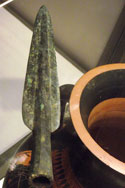
Spartan Spearhead
I have long been a fan of constructing ancient weapons and have found great joy in it. This summer I’m taking on a new project, a Spartan spear replica. It sure will beat a walking stick for hikes, particularly if a bear comes along. For its materials I’m going to be using Spartan Weapons as my source. The ancient Spartan warriors used a wood called cornel wood for their shafts. This is a very strong wood, known for its density. Unfortunately, it doesn’t grow in the US so I’ll be forced to improvise. The Saxon warriors (among many others) used the ash tree for this purpose. The word ‘ash’ is actually an old English word meaning spear. Ash trees have a hard wood, but it is also elastic, as its tight grain is resistant to splitting. Because of this is commonly used for bows, tool handles and baseball bats. In fact ash was used to make early car frames due to its ability to flex allowing it to function as part of the suspension system. The Morgan Motor Company of Great Britain still makes sports cars with frames made from Ash to this day for these reasons. Ideally I’ll be able to find a straight sapling for my Spartan Spear or dory as they called it. The shaft should be about 7-9 feet long.
The construction of the spearhead is out of my league however, I will be subcontracting this part of the weapon out. I will be using an authentic dark ages black smith, and hoping he doesn’t charge to much. (It will probably run in the $40 range). Iron was the most common metal used by the Spartans for spearheads, followed by bronze. I’ll be providing the black smith with images of Greek spearheads in order to ensure we are on the same page but I doubt this will be necessary as he is experienced in constructing them already. I just want to make sure that it is a narrower head like the examples found in museums as opposed to a wider head seen sometime in art and on film. Greek spearheads featured a long socket neck that the weapons shaft will fit into creating a secure business end.
I will also be ordering an iron butt spike. A bronze butt spike was most likely more common but having both ends made of iron certainly wouldn’t be out of the realm of what a Spartan spear would have used, they weren’t standardized to that degree. This will be used for standing the weapon up as well as spearing any lizards that happen by, seeing as the Spartans called this part of their spear the ‘lizard sticker’.
Once I have carved down my shaft and fit it into the spearhead an iron pin will be used to secure it. I will be seeking the blacksmiths advice on this part as well although it will ultimately be up to me to accomplish this. Unfortunately, I’ll be using a power drill to put a hole through the shaft but I’m not into constructing ancient weapon maker’s tools. I will be employing hand tools to form the shaft however.
The last step will be placing a leather grip on it; I’ll be using a wrapping technique to accomplish this. I’m unsure where I have seen images of Greek warriors wrapping their grips before battles. I’m hoping it was from a ceramic or relief and not some image that is stuck in my head from 300 (the inaccurate, although entertaining Hollywood movie). I’ll cut one long strip of untreated leather about 1” thick at the center and tapered at the ends to facilitate ting it in place. This is an area where some more research will be necessary along with a little “living history” trial an error.
Speaking of living history, this is where the fun begins. I will be able to dive into the old debate of weather the Spartan military typically used their spears over or underhanded. Ah, soon the neighbors will think I’m as nuts as my wife did when she found me and my 4 year old son throwing javelins at a couple of dummies. The dummies were old scarecrows she had in the garage and my son found it easier just to charge them and stab.
I’ll post back on my progress, so far finding the right tree has been a challenge but I’ll be spending a lot more time in the woods later this month. I certainly have learned a lot about trees. I’m very excited about this project and would like to hear from anyone who has made a similar Spartan spear or ancient weapon.

Greek Warrior
Posted in Ancient Weapons
Tagged dory, greek, history, hoplite, making a spear, Spartan, spartan spear, spartan warriors, spartan weapon, spear ancient, warrior, warriors, weapons
Leave a comment
Welcome to Ancient Military History!
Welcome to Ancient Military History, your place for information about ancient peoples and the conflicts that shaped their world. We will explore ancient weapons, tactics, grand strategy and the societies that employed them in their bid for dominance of the ancient world.

